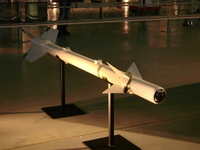About This Site
The title of this site is a mash-up of two different concepts. The first is "estimative intelligence," the academic term for long-term intelligence product with predictive (as opposed to descriptive) aspirations. The second is "circular error probable" or "CEP," the traditional quantitative measure of missile accuracy. In a literal sense, the title is appropriate because this site is primarily concerned with longer-term forecasts of strategic trends (as opposed to "current intelligence" or descriptive reporting), while maintaining touch with an assortment of technical particulars that I find interesting. "Estimative Error Probable," then, is the intelligence analyst's answer to the weaponeer's "CEP" -- a way of systematically thinking about the variation between prediction and reality.

This project is the successor to a series of websites that I began publishing a little over fifteen years ago. I began with Vulture's Row, which was initially coded to run on Lynx and provided coverage of U.S. carrier aviation. Shortly after that, I launched The State of the Russian Navy, mainly to house my research on post-Soviet naval developments. Over time, I added features on related subjects, including operational statistics on the Desert Storm air campaign, tips on digital aviation profile art, combat flight simulation, and the occasional photo essay.
But as time marched on, two things happened. First, the web exploded, and a multiplicity of other online sources emerged, serving up specialized information of a type that was once relatively unique to my project. Second, I graduated, started my career, and other life demands began to take priority. Eventually I stopped updating these sites entirely, although my aging archives have continued to be available at rjlee.org.
I've been intending to update the site for the past six years, but never managed to find the time. The truth is that I still don't have the time to research and maintain this site in the same way that I did ten years ago--but then again I'm not sure that such a site would be very useful today. The approach I plan to take with this "revival" is a lighter one, focusing on one or two projects at a time, without aspiring to "catalog" information already available from excellent sources elsewhere. One prediction in which I have very high confidence is that progress will be slow. But my hope is that, on occasion, this project will produce something of value.
-Robin J. Lee, Jan. 2, 2011.
estimative intelligence:
1. Intelligence that identifies, describes, and forecasts adversary capabilities and the implications for planning and executing military operations. Joint Publication 2-0, Joint Intelligence. 2. Intelligence that "[l]ooks forward to assess potential developments that could affect...national security...[and] helps policymakers think strategically about long-term threats." Intelligence.Gov.
1. Intelligence that identifies, describes, and forecasts adversary capabilities and the implications for planning and executing military operations. Joint Publication 2-0, Joint Intelligence. 2. Intelligence that "[l]ooks forward to assess potential developments that could affect...national security...[and] helps policymakers think strategically about long-term threats." Intelligence.Gov.
circular error probable:
An indicator of the delivery accuracy of a weapon system, used as a factor in determining probable damage to a target. It is the radius of a circle within which half of a missile’s projectiles are expected to fall. Also called CEP. See also delivery error; deviation; dispersion error; horizontal error. Joint Publication 1-02, DoD Dictionary of Military and Associated Terms.
An indicator of the delivery accuracy of a weapon system, used as a factor in determining probable damage to a target. It is the radius of a circle within which half of a missile’s projectiles are expected to fall. Also called CEP. See also delivery error; deviation; dispersion error; horizontal error. Joint Publication 1-02, DoD Dictionary of Military and Associated Terms.